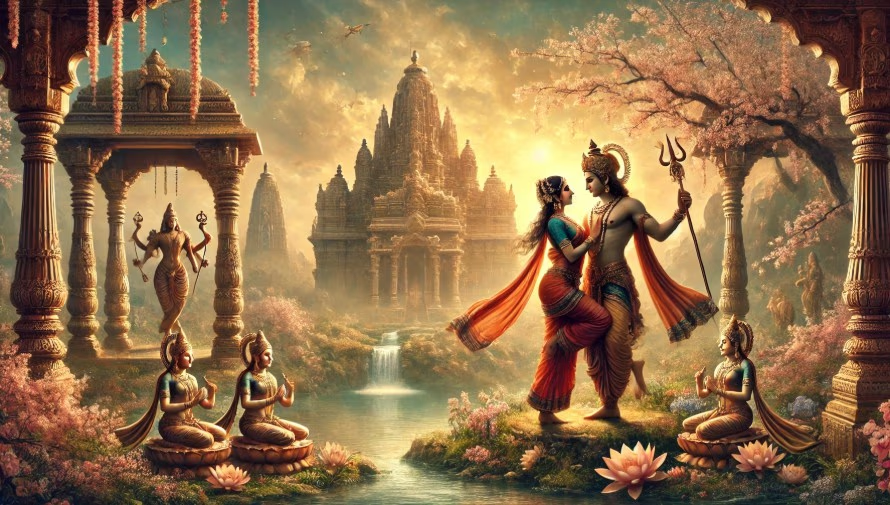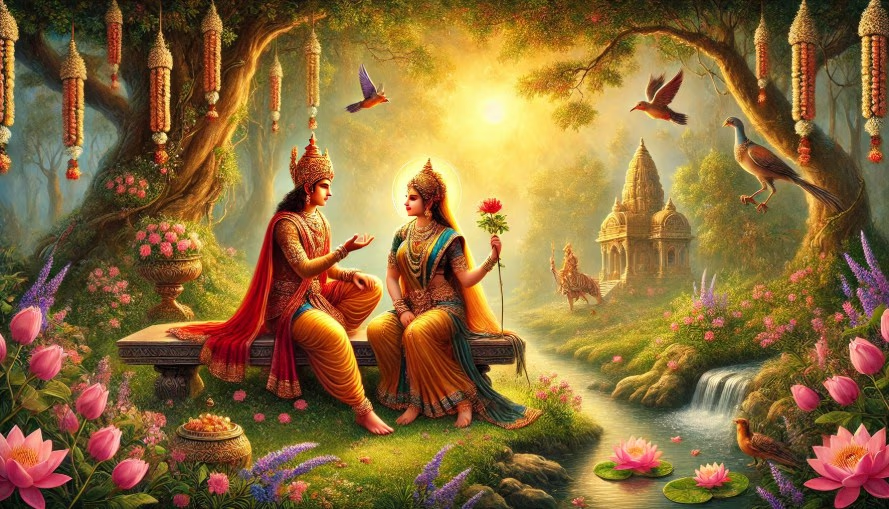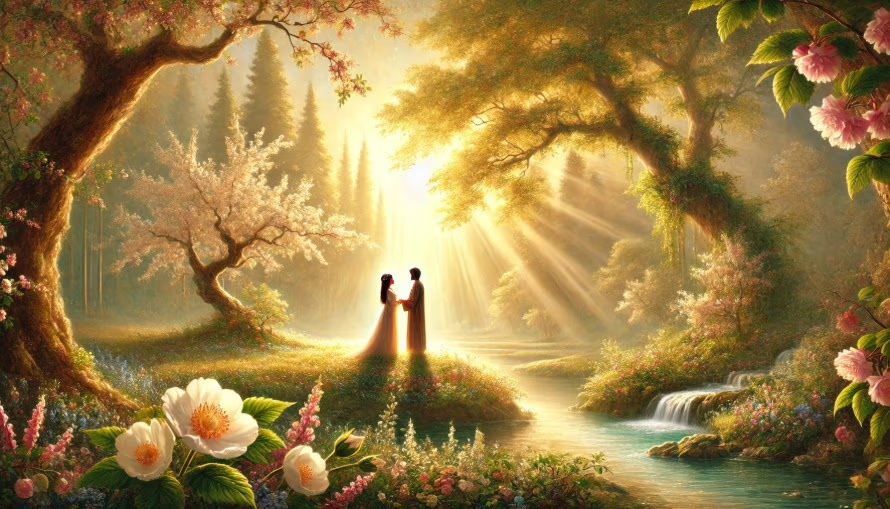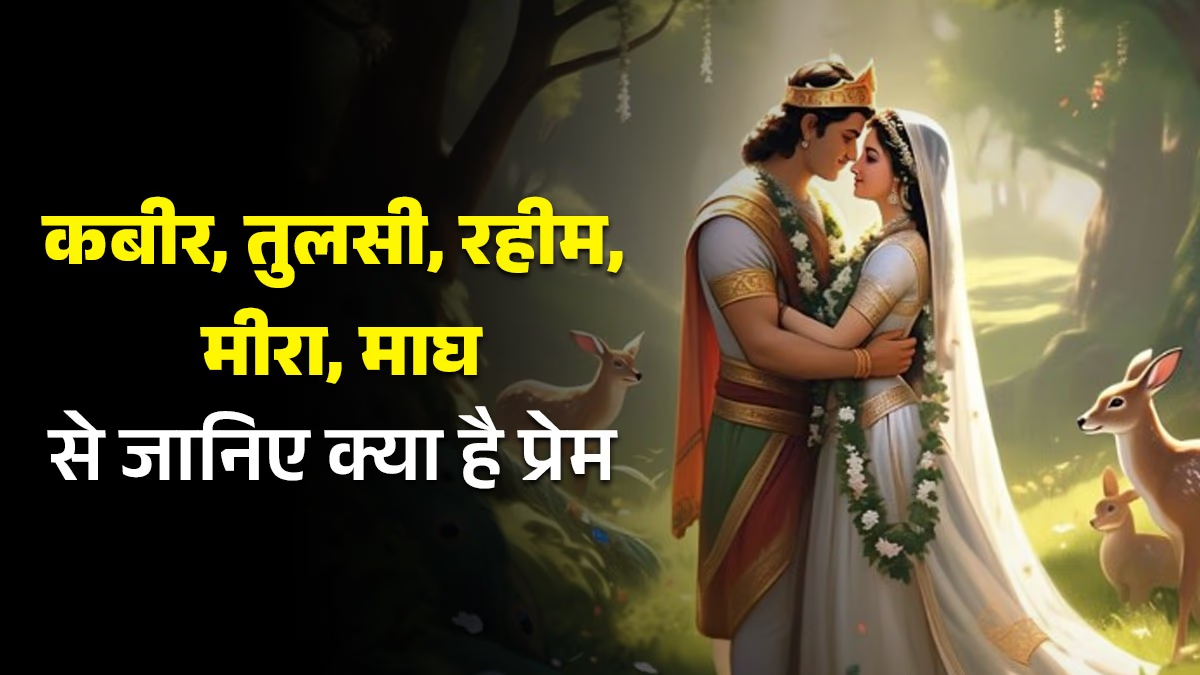As February begins and brings the Hindi month of Magh, India is graced with these two months that feel like moments when Earth is wrapped in the sun's warmth without getting too close. The weather is neither cold nor hot, the air is pleasing, and the sky is a burst of blue. Together, it creates an aura of a love-filled month, where declarations, promises, and grand gestures are abundant. From promising to gift the Burj Khalifa to dreaming of palaces, extravagant vows are common.
Hold on, my friend... Love is a delicate matter. Grand gestures aren't enough. First, it's essential to understand love thoroughly — this beguiling entity. As Jigar Muradabadi expressed, "This love is not easy, understand, it's a river of fire and you must walk through it."
Our story doesn't end here. What is love? This question must have burned in the human mind even before fire existed. From the universe's inception, love was the first emotion felt by beings of flesh and bone.
Depiction of Love in Rigveda
In the Indian Sanatan tradition, the Vedas are the earliest written documents, with the Rigveda being the oldest. The word 'love' appears prominently in the Rigveda. It describes love marriages and emphasizes sacrifice as essential to uphold love. Sacrifice is the axis of love — partners should not test each other's capability of sacrifice, but rather not fall short in sacrificing from their side for the other.
The 85th hymn of Rigveda's 10th mandala is called the marriage hymn. It speaks of love marriage, telling the story of Surya's daughter's love marriage. It also contains counsel for marital couples on their interaction with family and society. The final hymn of Rigveda's 10th mandala, the 191st hymn, speaks of love and harmony, and it's referred to as the serenity hymn of Rigveda.
Sanskrit Mantras from Rigveda
(not modifying or translating Sanskrit Verses as per instructions)
Rigveda also discusses love blossoming between man and woman and the desire for love among all creatures. To fulfill this desire, sacrificial offerings (havi) were made in the fire. From here, the definition of love evolved. The definition asserts that there is no place for deceit in love, no space for desire; love means the unification of two.
First Experience of Love by Adikavi Valmiki
When Adikavi Valmiki was planning to write his most significant text, the Shrimad Ramayana, he was troubled for several days. He couldn't decide where to begin the Ramayana. Lost in this dilemma, he went for a bath in the Mansa river one day. The weather was pleasant, and by the riverbank, a pair of Karunch birds were mating joyfully. The sage felt joyful witnessing this sight, but suddenly, an arrow came whistling through, striking one of the birds. Watching the male bird die, the female bird also beat her head in sorrow and perished.
Filled with grief, Adikavi, barren of poetry till that moment, gave vent to both love and sorrow together.
Curse Shloka
(not provided in English translation as per instructions)
The lament of the Adikavi evolved into poetry, thereby crafting the first verse of Ramayana. But then, is sorrow indeed the root of love? Is this where it originates? The answer to this question is given by Brahma himself to Manu and Shatrupa, according to Bhagavata Purana.
The creation story continues with Brahma manifesting four youthful seers from his pure feelings — Sanaka, Sanandana, Sanatana, and Sanatkumara. He instructed them to seek knowledge and, upon maturity, marry to carry forward creation. However, these seers, though they sought knowledge with fervor, refused to marry, claiming their thirst for knowledge was unquenched, and thus, they did not wish to engage in matrimony. Brahma, consequently, cursed them to remain ever youthful and continue seeking knowledge.
Creation of the First Pair of Man and Woman by Brahma
Poet Jayshankar Prasad encapsulates this divine discussion and the first meeting emotions of Manu and Shatrupa in his literary work 'Kamayani'. Here he refers to Shatrupa as Shraddha.
"On the rocks of the ages, the universe boldly strides / Gods, Gandharvas, and Asuras unintermittingly follow her."
The poem beautifully illustrates the cosmic dance and interplay of creation with love, portraying its eternal depth and significance.

Source: aajtak
Kalidasa's Depiction of Love
Sanskrit verse on Shiva and Parvati's Encounter
(not provided in English translation)
The experience captures the ethereal love Parvati feels, even amid divine impulses of karuna (compassion) and reverence, which stabilizes her with the continuous chanting of Namah Shivaya.
Bharavi's Poetry of Love
Bharavi's Verse on Arjuna
Magha's Philosophical Definition of Love
Magha's Verse on Love
Incomparable Love of Mirabai
Mirabai expresses through her verses an unyielding devotion to Krishna. She drinks the poison sent by Rana with a smile, not bothered by societal conventions, with only Govind in mind — her consort, friend, and divine force.
Mirabai's Devotional Verse
Divine Love of Tulsidas's Rama
Sanskrit verse on Rama's Love
Love Beyond Material Attraction
In conclusion, love isn't merely physical attraction or emotion; rather, it is an eternal mantra surviving beyond mortal existence. Love is synonymous with the soul as described in many interpretations. However, the simplest explanation comes from Kabir, Rahim, and various poets of the Nigun trend.

Source: aajtak
Rahim's Depth of Love
Rahim's Couplet on Love
Rahim on Breaking Love Knots
Sensitive Thread of Love
True Love without Exchange
Path of Love: Cautionary Verse by Rahim
Earthy Wisdom of Ghagh on Love
Ghagh's Proverbial Wisdom

Source: aajtak
Timeless Elements of Kabir's Love
Kabir describes worldly love varieties and underscores supreme love for Lord Rama, recognizing it as the world-driven highest form of love, as divine love.
Kabir on Divine Love
Reflections of love, knowledge, and yoga in Kabir’s practice showcase the integral role of love at every stage. Upanishads articulate, ‘worship God by wholeheartedly considering Him dear.’ Kabir's love meditation transcends our love boundaries, filled with compassion and heart-centered devotion.
In simple terms, Kabir explains:
Kabir's Simple Love Philosophy
Kabir asserts that love isn't available for cultivation or sale; whether royalty or commoner, one sacrifices to gain it.
He also insists on constant commitment in love; if emotions fluctuate, it signifies unreal love. True love dwelling in the soul doesn't diminish.
Thus, Kabir's surrender theme prompts selflessness over ego, facilitating love fulfillment. His desire and yearning for this union as portrayed in Sahaj’s Sakhi manifests deep dedication: "Neither rise nor fall, love's neither easy nor achievable through logic."
Moreover, Kabir anchors love depiction in spiritual marriage, framing human-divine union via love. He describes the cause of soul-Paramatma connection as love's completeness, likening the husband-wife relation that thrives uniquely in totality. Within this context, he emphasizes ego vanishing within the love mystique: "Ego presence nullifies love’s expression."
This profound revelation of ego hindrance preventing love is addressed by Amir Khusro in his writings. His verse visually elaborates this separation distress experienced deeply, as portrayed through long-dark hair similes and longing for the beloved.




